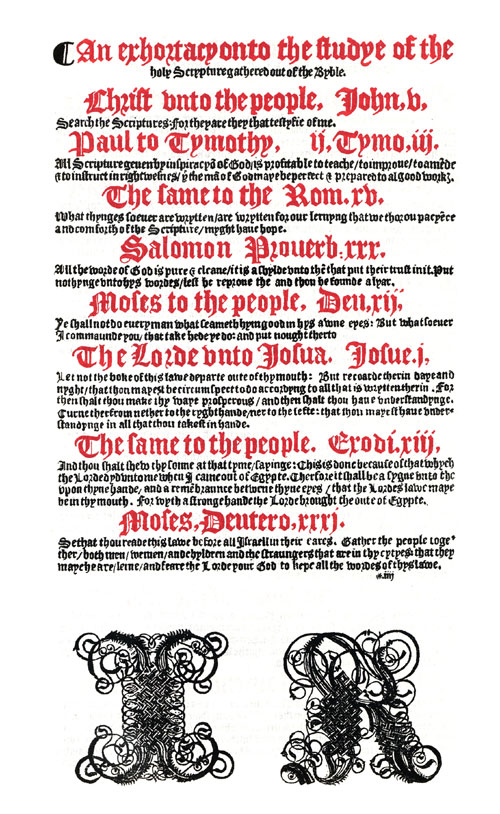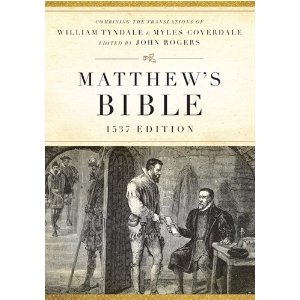Thomas Matthew Bible - John Rogers Society

Details
- Bible sanctioned by Royal License and Proclamation.
- Coverdale not connected with Tyndale or Rogers.
- Coverdale's Bible was not accepted at all, despite "...possessing almost unbounded influence,..." yet Rogers' Bible was immediately received with "...almost frantic joy by the Archbishop of Canterbury..."
- Grafton only wanted a part of Rogers' publishings to get rich, though he was declined, and in his asking was described as "...amounting in one or two instances almost to blasphemy...".
- Rogers put in the Bible Prefaces, Prologues, and Marginal Notes, which were later removed in the next edition of the book by Cranmer and Coverdale.
- With Coverdale's Bible, he "..carefully avoided attacking many of their chief doctrines.." while Rogers made sure to point out everything wrong with the church.
- Coverdale also replaced the word "repentance" with "penance."
- Coverdale never suffered any persecution and was able to travel safety "..only fourteen days after the burning of Rogers, going freely and in safety to the continent, actually the bearer of a letter from Queen Mary herself to the King of Denmark!" Strange, considering Rogers was burned at the stake, yet Coverdale went unharmed.
- "Often Miles Coverdale is attributed with the work of Rogers, but Coverdale is one who scholars have called an adapter and not a translator. He reportedly knew neither Hebrew nor Greek and relied on 'five sundry interpreters' of Latin. C.S. Lewis said Coverdale was 'of all the translators…the least scholarly' an ignorant yet sincere man, 'a rowing boat among battleships' who 'might perhaps be regarded as a mere hack'.. Coverdale survived his initial persecution and went on, with Cranmer, to change The Mathew Bible by rewriting the portions that were 'offensive' to the church." (https://thematthewbible.com/2022/01/24/tyndale-rogers-coverdale/)
- Even if Rogers is not given the title of the author of the first English translated Bible, he still had the first English Commentary, etc.
- In the Bible Rogers placed "A Table of the Principal Matters contained in the Bible, in which the Readers may find and practise many Common Places." He also put in a Dictionary, a Concordance, and a Commentary.
- Rogers main object that he was directing attention to was "..those portions of the Bible which were in plain opposition to the then distinctive doctrines of the Romish Church,..."
- Some subjects Rogers was particularly keen on were "..mass, the real presence, and the marriage of priests..."
- The goal was to not just give the public a version of the Bible they could read, but one they could understand, and to push them in the direction of certain teachings that contrasted with what the Church was teaching them.
- Rogers also put in "The Sum and Contents of all the Holy Scriptures, both of the Old and New Testament."
- He also put in "An Exhortation to the Study of the Holy Scriptures, gathered out of the Bible."
- Title page said "The Bible, which is all the Holy Scriptures: in which are contained the Old and New Testaments, truly and purely translated into English by Thomas Matthew."
- "..two large wood-engravings, viz. the Title and 'Adam and Eve,' were 'struck from the blocks which had been used in a Dutch Bible, printed at Lubeck, in 1533'."
- Title printed in red and black, "..in the centre of a fine wood engraving which fills the entire page."
- Table of Contents.
- Calendar and Almanac for 18 years "..beginning with the year 1538, occupying four pages."
- Dedication to King Henry VIII (3 pages).
- 14 and 1/2 inches in length by 10 and 1/2 inches in width by 3 inches thickness.
- Embracing the text only is exactly 11 and 1/4 by 6 and 1/2 inches.
- Including the marginal notes, running titles, and signatures 12 by 8 and 3/8 inches.
- The Canticles are printed in red and black.
- There are seventy-eight wood-cuts in various parts of the book, two of which......extend the entire width of the page. Those in the Revelation have around them a double border of flowers."
- Whole Bible was divided into chapters, chapters into paragraphs, but no verses.

[Source: Joseph Lemuel Chester, John Rogers: the compiler of the first authorised English bible, the pioneer of the English reformation and its first martyr; embracing a genealogical account of his family, biographical sketches of some of his principal descendants, his own writings etc. etc., London: Longman, Green, Longman, and Roberts, 1861.]
Notes
1. Coverdale the imposter.
2. Which Bible had the king's license first?
3. God moved upon Rev. John Rogers and John heard.
4. John heard the voice of God
5. John followed through.
6. John knew the Bible.
7. John sided with the Bible and married.
8. John brought the wealth of the Bible to the common man.
9. John added over 30 pages of introductory material that rapidly brought the public up to speed regarding what the Bible did and did not teach.
10. John added numerous side notes throughout the entire Bible.
11. Different words were significant "church" verses "congregation"; "repentance" verses "penance", etc.
12. Subsequent Bibles used the Matthew's Bible as the de facto Bible to improve upon. The marginal notes however were left out until the publishing of the Geneva Bible.
© John Rogers Society
